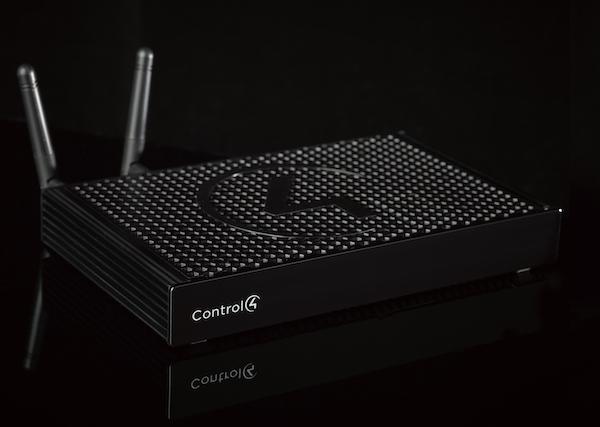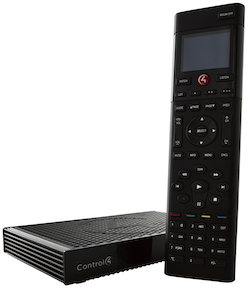Control4 Makes Awesome Automation Affordable

Each one of the controllers in Control4’s new EA Series—the EA-1, EA-3, and EA-5—has its own particularly compelling features and general use cases (e.g., square footage of the home, number of devices to be controlled, and etc). Extensive home automation systems can be built using one or any combination of them, as well as in combination with Control4’s previous HC Series controllers. Somewhat surprisingly, however, is that the controller that impresses me the most happens to be the one with the fewest features. It’s also the one with the lowest price tag.
To understand why I’m so jazzed about the new controllers—and the EA-1, in particular—might require some context. Control4, in case you don’t know, doesn’t live in the DIY smart home neighborhood. You won’t find $50 smart home hubs with Control4’s name on them at Home Depot. It’s quite the opposite. Control4 systems must be professionally installed and, most importantly, professionally programmed.
Regarding home automation, when most of us (including me) hear “professional” we immediately think “expensive”—usually “very expensive”. Now isn’t the time to get into a discussion of the relative merits, drawbacks, costs, and benefits between a professionally custom-installed home entertainment/automation system versus what’s typically thought of as the DIY smart home. I have two reasons for not devoting blog space to the issue: 1) it’d take too long to do it justice; and 2) the $600 Control4 EA-1 controller bundle blurs the typical lines dividing the two approaches.
I dislike the term “game changer” because it’s so overused as to be meaningless. That being said, Control4’s EA-1 controller deserves special recognition; and you can make a good case that “game changer” does indeed apply here. Based on reason #2 in the previous paragraph, I could go with “line blurrer”; but that’s a little vague. Instead, let’s use “room changer”. It’s much more appropriate for the EA-1 bundle in both the letter and the spirit of that short phrase of praise.
As I noted earlier, one of the significant attributes of the Control4 EA-1 is the price. At $600, it’s not the cheapest home entertainment and automation controller in the world; but it’s not in the stupid-expensive category either. Affordability is always in the wallet of the beholder, but $600 for a pro-level automation controller is significantly more affordable than the typical $2,000 to $3,000 price tag.
For all that it does (and I get into that momentarily), six hundred bucks is a good deal for the EA-1. But a sophisticated black-box (and, for the most part, it is a black box) isn’t all you get for your money. Technically, the EA-1 is actually sold as a bundle because it comes with a Control4 SR-260 handheld remote control.
 The SR-260 isn’t one of those el-cheapo credit-card style remotes or even a full-size handheld with a basic, non-intuitive button layout. It’s the real deal when it comes to universal AV remote controls, with an OLED screen, backlit buttons, a light sensor (for automatically adjusting brightness), a motion sensor (that wakes up the remote when picked up), and an optional recharging cradle.
The SR-260 isn’t one of those el-cheapo credit-card style remotes or even a full-size handheld with a basic, non-intuitive button layout. It’s the real deal when it comes to universal AV remote controls, with an OLED screen, backlit buttons, a light sensor (for automatically adjusting brightness), a motion sensor (that wakes up the remote when picked up), and an optional recharging cradle.
The SR-260 is missing something, though: an infrared (IR) emitter. It communicates with the EA-1 using ZigBee, and the EA-1 takes care of issuing the correct signals to control your equipment—which could be via IR (blasters), IP (over Ethernet or Wi-Fi for Apple TV, Roku, or other network connected devices), ZigBee (usually for locks and sensors), or even old-school RS-232. Using the wireless ZigBee protocol for communication between the SR-260 and the EA-1 offers a couple of other benefits. First of all, you don’t have to worry about which way the SR-260 is pointed to operate your AV gear. Second, unlike IR signals, ZigBee can travel through walls (with limitations). That means you can control your gear from another room, if you want to.
You may not be big on the idea of controlling your home theater system from, say, the kitchen. Nor am I, although it can sometimes be fun to adjust the volume or change channels to freak out your kids when they’re watching TV with friends. So, what’s the big deal about using the SR-260 in another room?
Well, that’s the other reason to covet the EA-1 bundle. So far, the combo seems like a rather expensive universal AV remote control. But there’s more to it—much, much more, in fact—because the EA-1 is a first-rate automation controller, too. (It’s also a high-resolution audio streamer/player with, from what I was able to glean from the brief demo I sat through, exceptional analog audio performance.)
When used with compatible smart devices (and there are a freighter load of them), the EA-1 can dim the lights in your living/theater room, close the curtains, lock the front and back doors of your house, adjust the thermostat, plus a number of other things, like providing access to video from security or baby-room cameras.

It’s certainly not a trivial thing to program a sophisticated universal remote control. Anyone who’s ever worked with one of higher-end Harmony remote controls know that in spades. Programming a SmartThings or Piper smart home hub requires more than a few mouse clicks, too. That’s why you really don’t want to program a Control4 system, be it the EA-1, EA-3, or EA-5. It’s also why Control4 doesn’t let you program one of their systems. As I said earlier, Control4 can’t be found in the DIY aisle of your local hardware store. It takes at least a full day of intensive training just to learn the basics of the Control4 programming software (Composer Pro)—I know, I’ve been through it—and then you’ve just scratched the surface of what can be done. A Control4-trained professional installer with a little imagination can make your home do some amazing things, so, yes, it’s worth the money.
Since every installation is different, with lots of variation amongst the number and types of AV gear and smart devices involved, it’s nearly impossible to tell you how much you’ll need to pay for the labor to install and program a Control4 system with an EA-1 at the heart of it all. You can pretty much bet it’ll be a couple hundred dollars, at the very least. Get a quote from your dealer up front so you won’t be surprised at the end of the install.
If you need a baseline by with to judge the value of a professional install, my experience is that it’ll take a relative newbie at least three, if not a couple more, hours to program and troubleshoot the Logitech Harmony Elite universal AV remote and smart home hub.
There’s a heck of a lot more that I could go into, like the free Android and iOS (including the Apple Watch) mobile control apps, and the fact that Control4 continually updates the OS that’s the backbone of every Control4 system. The previous update, OS 2.8, added Shairbridge, a software-based implementation that gave the company’s controllers AirPlay compatibility without requiring the purchase of additional hardware. The update that will be released today, OS 2.8.1, will add, among other things, native support for Deezer, Pandora, and TIDAL.
The EA-3 and EA-5 build upon the feature/function foundation in the EA-1, adding processing power, inputs and outputs, more control and Ethernet ports, the capability to stream multiple high-res audio simultaneously (3 for the former, 5 for the latter), and enough extra stuff it’d take a day or so to list and explain. Needless to say, as amazing as the EA-1 is considering its price, the EA-3 ($1,000) and EA-5 ($2,000) are equally so in their categories.
The simple takeaway is this. It’s been a long four years since Control4 introduced the previous-generation HC Series controllers. Now that I’ve had a chance to look at the new EA Series controllers and what they can do, I can tell you it has definitely been worth the wait.
- Log in or register to post comments








































